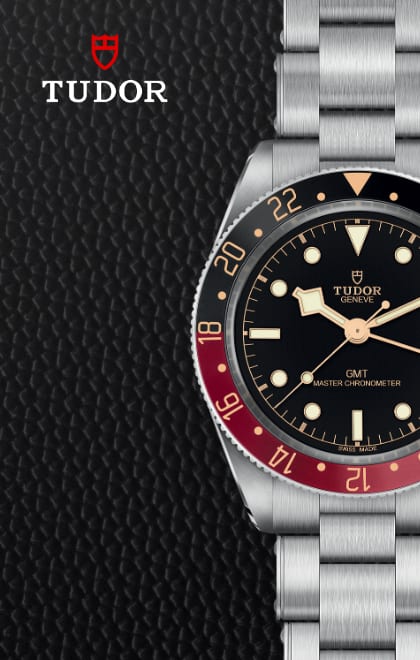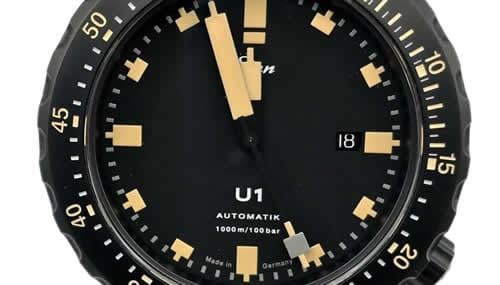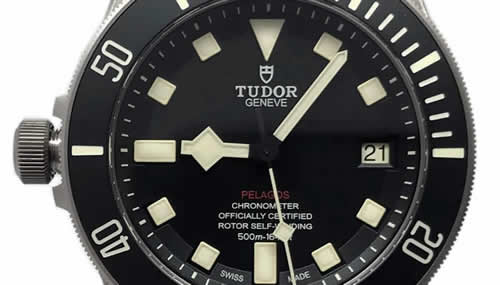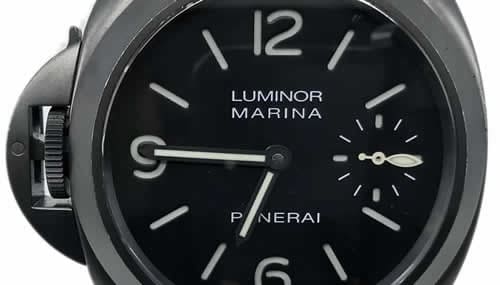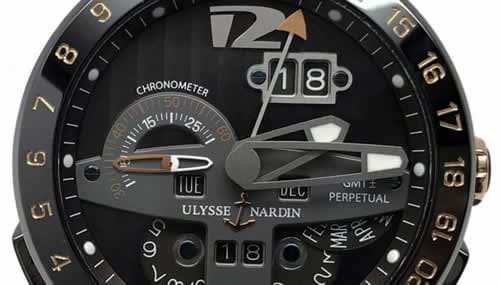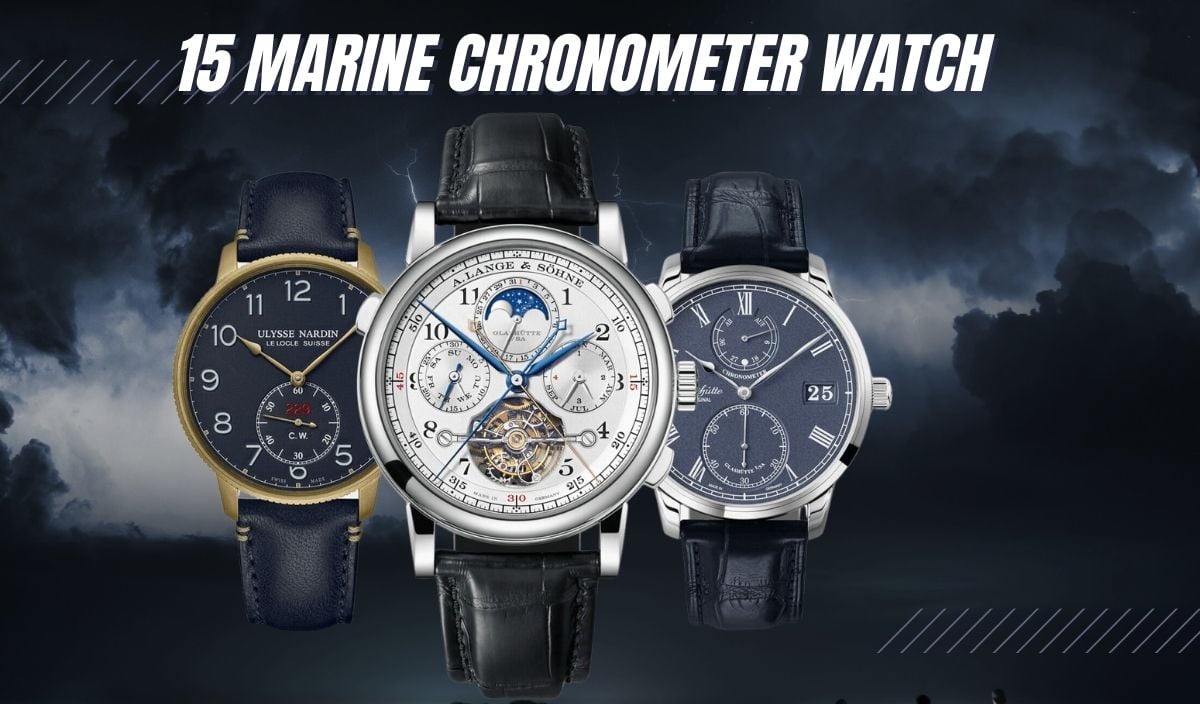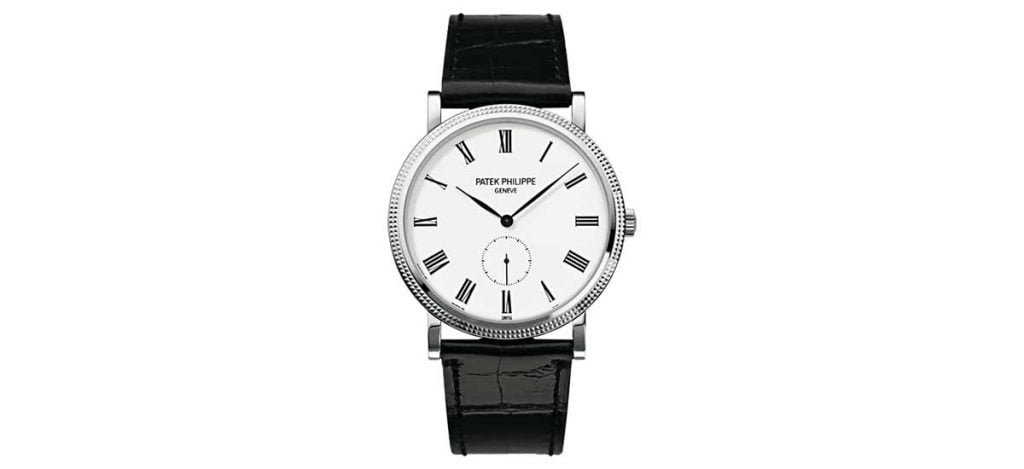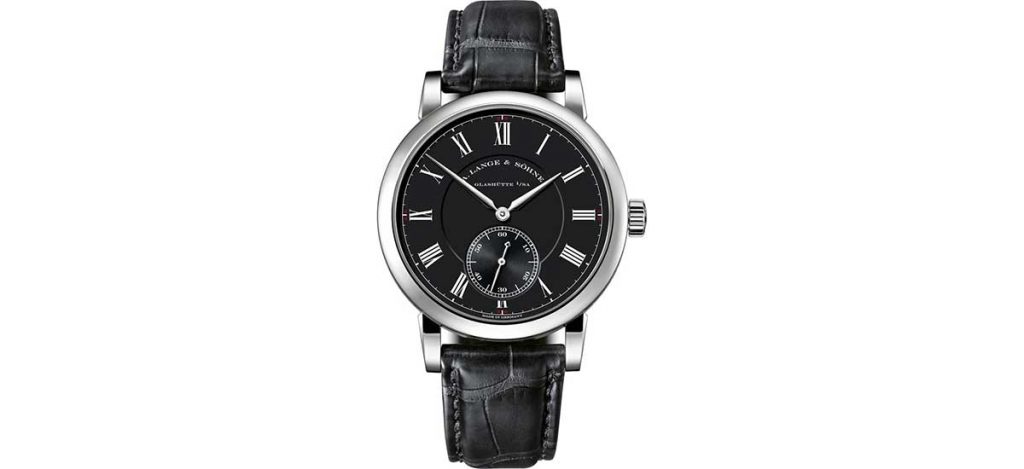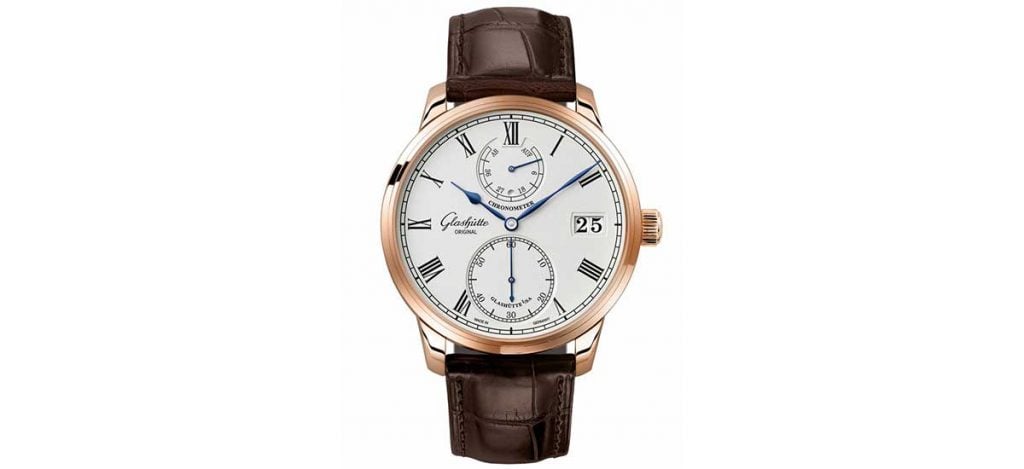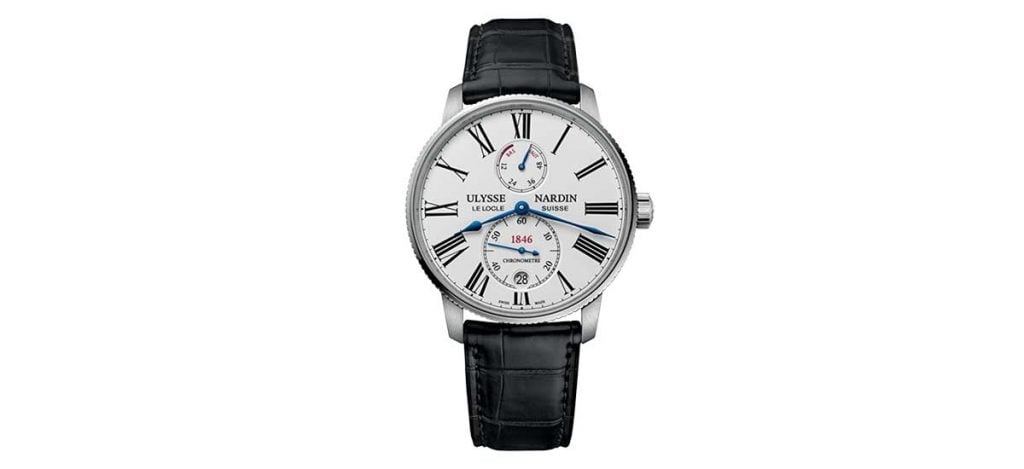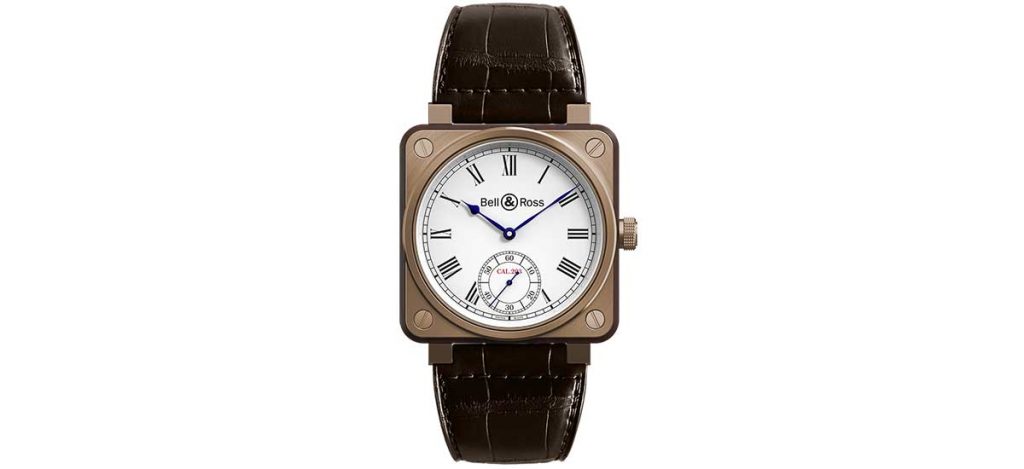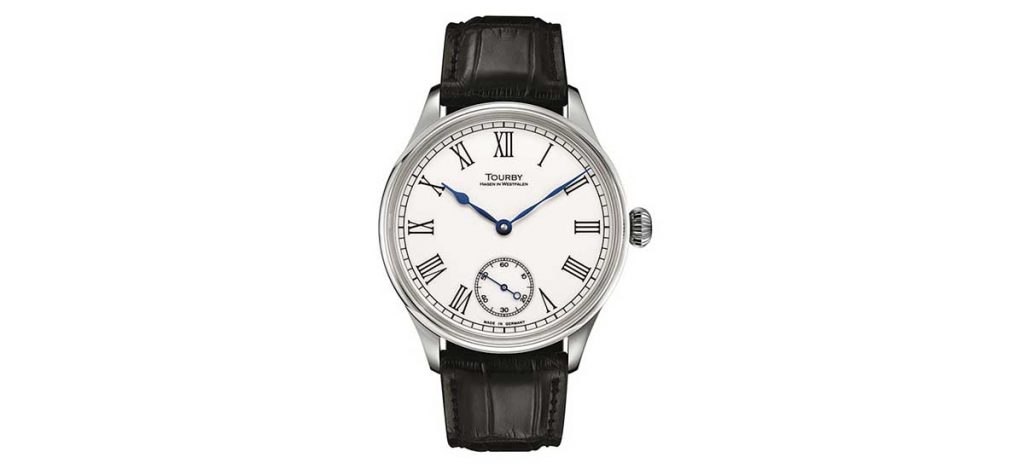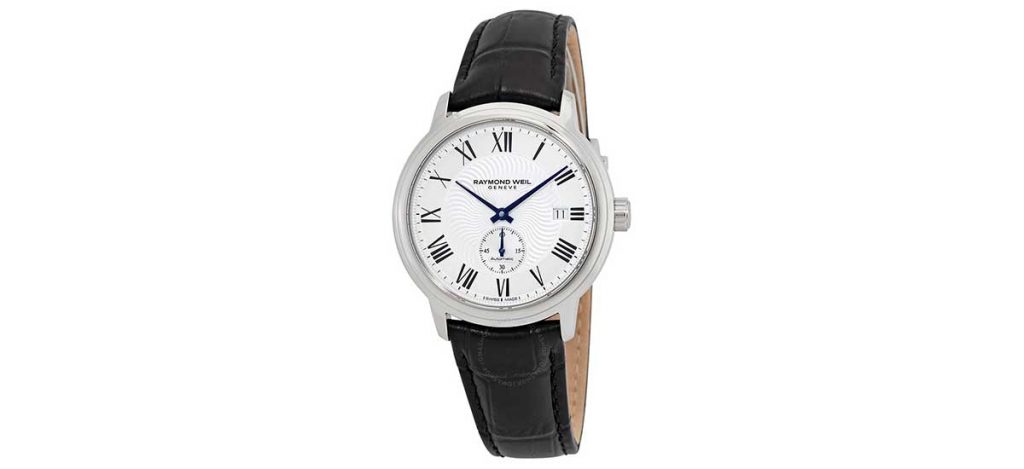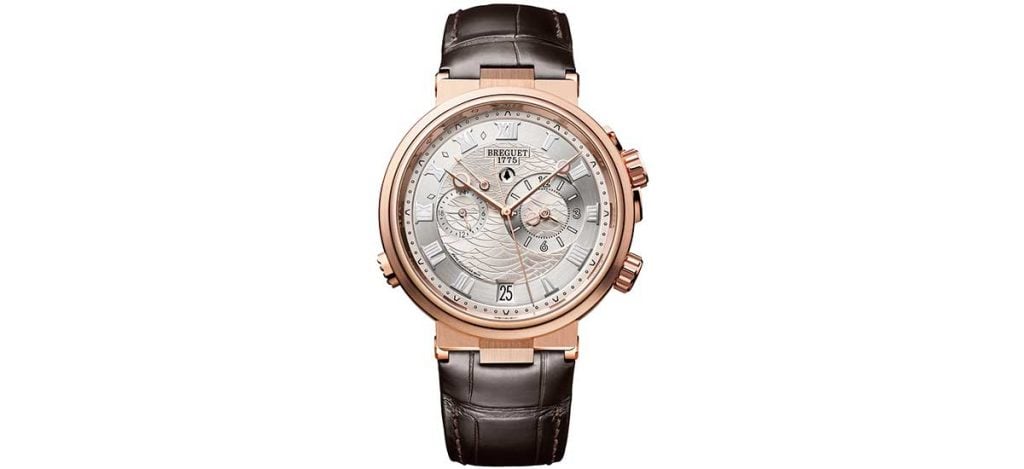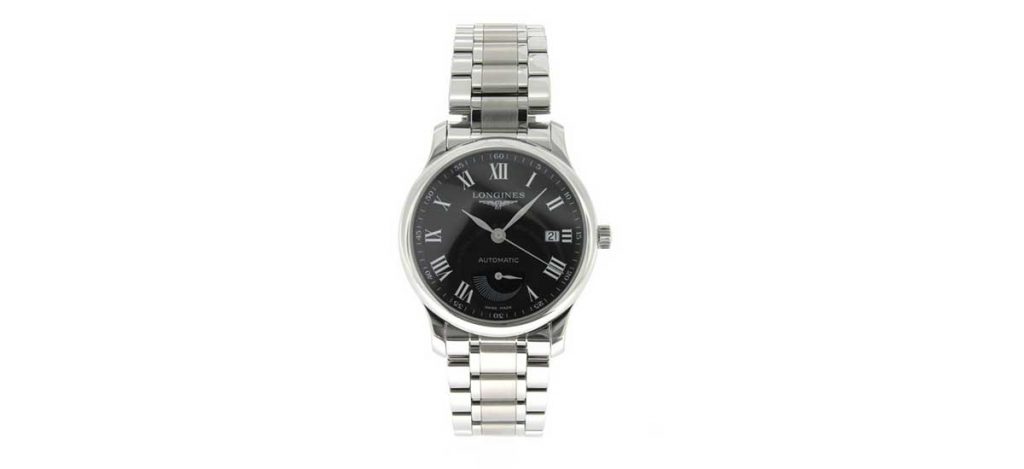
Mechanical watches with alarm functions used to be all the rage in, say, the 1950s. But over the years, they understandably took a back seat to modern gimmicks, such as the smartphone or the digital alarm clock. For this reason, mechanical alarm watches seem to have fallen out of favor with watch enthusiasts and manufacturers alike.
In my eyes (rose-tinted though they may be), this is a great shame. Not only is the on-wrist alarm feature useful in everyday life, but these watches also grant the wearer an element of style and hold a degree of historical gravitas that the iPhone inherently lacks.
Alarms Before The Snooze Button
The first mechanical wristwatch with an alarm function was introduced by Swiss watchmaker Eterna in 1914, thanks to a patent filed in 1908. Unfortunately, the watch didn’t do very well, and pocket watches remained the preferred timekeepers du jour.
It wasn’t until 1947 that the alarm watch gained popularity with the release of the Vulcain Cricket, a hand-wound timepiece with two barrels that emitted a chirping chime.
The Cricket’s acclaim was inevitably boosted by its association with several US Presidents, including Eisenhower, Truman, Nixon, and Lyndon Johnson. It was even marketed as ‘The President’s Watch’. From Truman onwards, mechanical alarm watches found their place in the world amongst collectors and casual wearers alike.
Mechanical Alarms in The Age of The Smartphone
If, like me, you’re an analog kid meandering through a digital world, then the simple joy of a physical chime is worth far more than all the smartphone apps money can buy. As bespoke market sectors continue to serve discerning buyers, we’re seeing an interesting trend towards more tangible items (the vinyl resurgence is a strong example of this, as is the revival of interest in classic cars).
This is no different for watches – as more buyers become aware of the allure of owning something that tells a story, utilitarian traits are no longer the determining factors behind many purchases.
Enter the mechanical alarm watch. Do you need a mechanical alarm on your wrist? No. Does wearing one tie you into a rich and meaningful network of creators and appreciators spanning generations? Hell yeah, it does.
The Best Watches With a Mechanical Alarm
Patek Philippe Grand Complications (ref. 5520P-001)
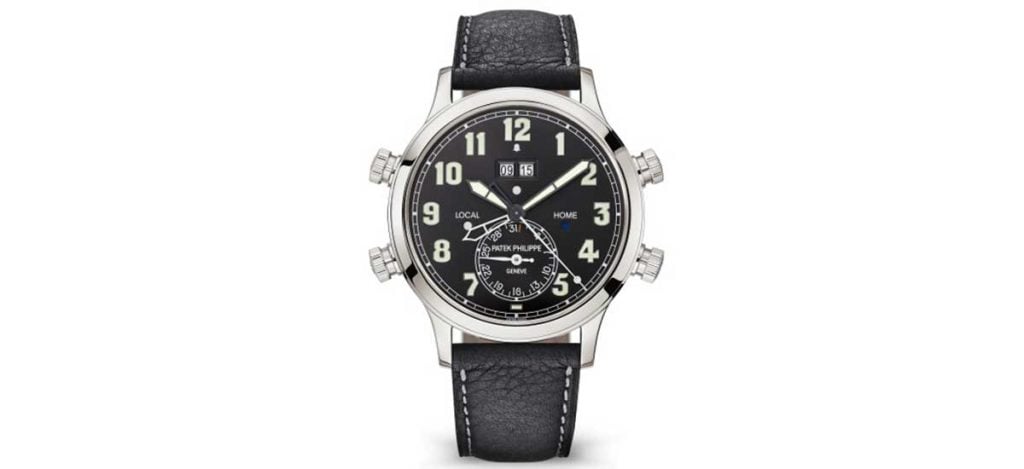
The Patek Philippe Grand Complications 5520P is pretty much what it says on the box – a luxury travel watch with some fairly lofty complications, one of which is an alarm that uses a musical hammer-and-gong-style chiming mechanism instead of the typical vibrating, buzzing sound.
It’s a continuation of the Calatrava Pilot Travel Time collection with the definitive addition of the alarm complication. On the face lie two 12-hour-format time zones and a date dial, all presented in a fairly modest manner, despite the watch’s somewhat exuberant name. With an ergonomic and logical design, the alarm time is set in five-minute increments using a couple of digital windows under 12 o’clock.
A small circular window indicates AM or PM, and a bell-shaped window shows if the alarm function is on or off. The watch also has two more distinct AM/PM indicators on the dial, one for each time zone – a subtly nifty feature for the frequent travelers among us.
Driven by an automatic movement that includes high-performance proprietary components, it’s safe to say you’re getting exactly the quality you’d expect from Patek. The case is 42.2mm-wide and 11.6mm-thick, made of solid 950 platinum. In other words, it’s as sturdy as they come.
The alarm chimes are impressively loud, thanks to the gongs being attached directly to the case to create an overall audio reverberation system. This work of sheer genius from Patek will set you back a cool $226,800.
Jaeger-LeCoultre Polaris Memovox (Q9038670)
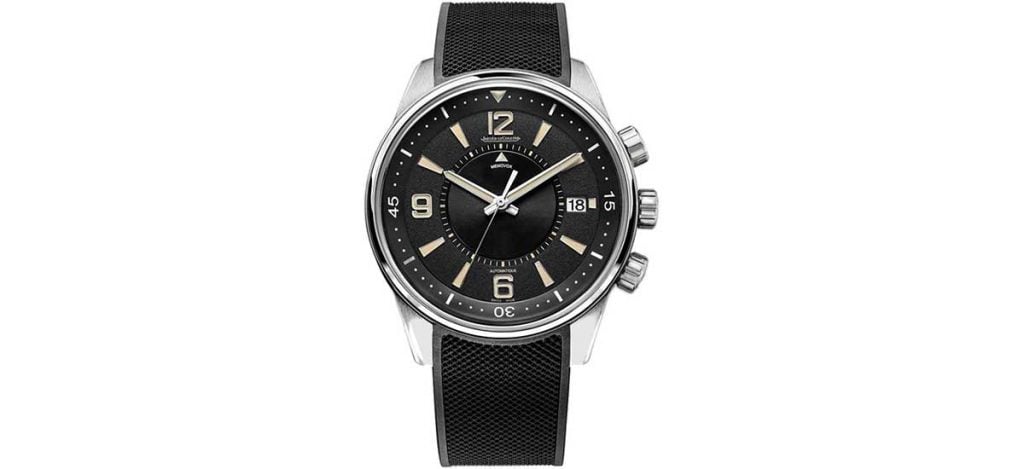
Jaeger-LeCoultre celebrates the 50th anniversary of its iconic Polaris watch with the release of 1000 units that is a modern take on the original 1968 design, a watch that I would do almost anything to own. The limited edition Polaris Memovox’s defining characteristic is its pointed circularity – a design that is somehow sharp and rounded at the same time, thanks to elongated baton hands and an inner-dial indicator for the alarm function.
The black face has a vintage feel with vanilla-colored markers, which are filled with faux-aged lume that makes this whole thing look extra yummy. Retaining the classic three-crown set-up, the inner rotating bezel, and the original Polaris alarm function (duh), this edition features new elements such as a three-finish black dial and a mix of complications.
The alarm has a classic report – what I would refer to as the ‘old school bedside alarm’ sound and is the ideal balance between charming and, well, alarming. With a 42mm stainless steel case and a thickness of 15.9mm, this isn’t the smallest watch, so if you’re a stickler for size, bear that in mind. With that being said, though, it’s not nearly as thick as its predecessors, and a very minimal case and bezel serve to lessen this issue even further.
The in-house Caliber 956 movement is specially assembled in Jaeger-LeCoultre’s complications workshop to ensure the highest standards of distinction. All-in-all, this Polaris Memovox release proves that this iconic line just gets better with time.
Vulcain Nautical Trophy (100107.024VT)
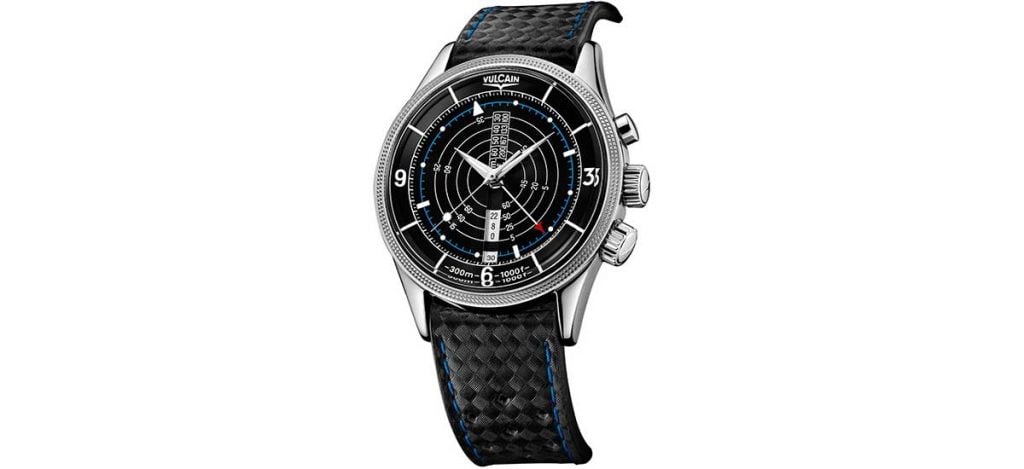
The Vulcain Nautical Cricket is a legendary watch introduced in 1961 as a true diver’s instrument. Designed with the help of diver Hannes Keller, who held the record for the deepest dive at the time, the watch had an alarm complication and decompression tables built right into the dial, features that may be a tad busy for some while absolutely essential for others.
Today’s Nautical Trophy was released as a special edition watch in 2011 and exudes a slightly-updated 60’s charm; a clous-de-Paris bezel visibly differentiates this piece from the original at face value. The dial’s outer ring is dedicated to conventional time-telling duties, with a simple 3, 6, and 9 configuration, while on the interior of the dial, the decompression table takes precedence. Legibility is a bit of an issue at first, but once you get used to the details, it’s a breeze.
The 42mm steel case is slightly elevated on the wrist thanks to the triple-caseback, but it’s worth the extra height. The Nautical Cricket is a great piece of mechanical tech to behold, and although I long for an open caseback through which to view Vulcain’s impressive caliber V-10 movement, I’ll take the working alarm function as a handsome trade-off.
Oris Big Crown ProPilot Alarm Limited Edition (01 910 7745 4084-Set LS)
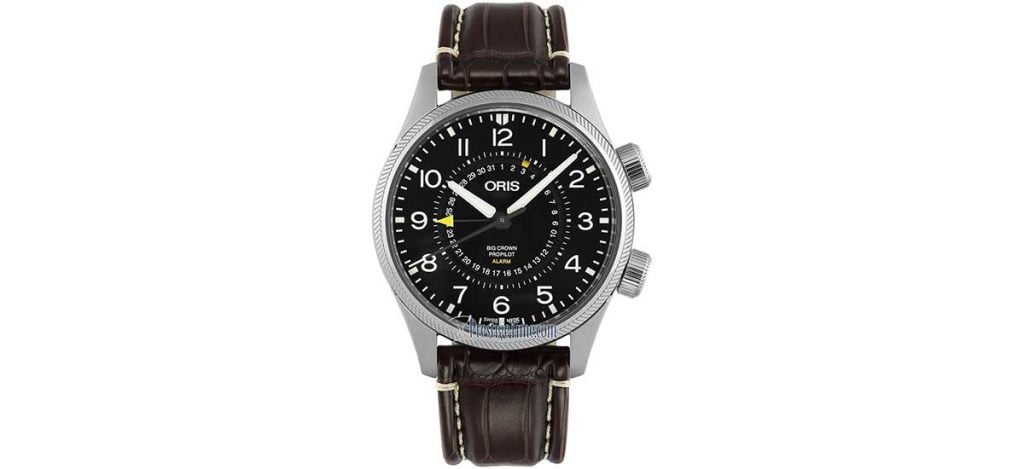
Oris is a company known for its robust and functional watches, and their limited-edition Big Crown ProPilot Alarm is no exception. This model features a mechanical 12-hour alarm function, indicated by a vibrant, yellow-tipped central hand that points at an inner ring to show when the alarm will go off, similar to the Memovox mentioned above.
The alarm can be set in 10-minute increments via the crown that lies between 3 and 4 o’clock, while the watch also includes a rotating date function displayed through a circular aperture in the dial. At 44mm and boasting 2 oversized crowns and a knurled bezel, this is certainly the most masculine watch on the list thus far.
With that being said, there’s nothing particularly confrontational about the ProPilot. Limited to just 250 pieces, this big boy comes on a dark brown crocodile leather strap with Oris’ signature airplane seatbelt-style clasp and has a sapphire crystal on the dial side.
Oris’s own Calibre 910 movement powers the watch and includes automatic winding, central hours, minutes, and seconds, as well as the aforementioned ring-date function, which is a very satisfying addition by any measure.
Tudor Heritage Advisor (79620T)
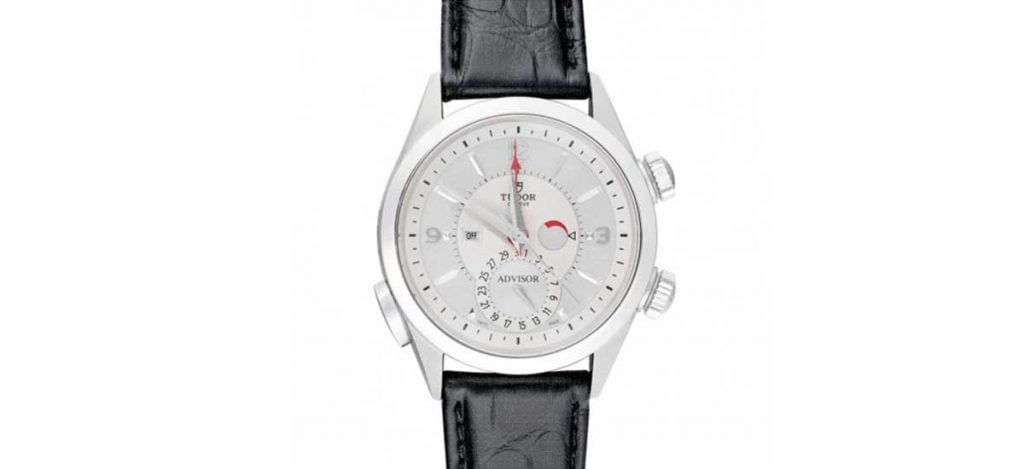
The Tudor Heritage Advisor pays homage to its 1957 predecessor while incorporating tastefully modern design elements that are very… Tudor. The 42mm satin-brushed and polished titanium case sits on either a cognac-colored alligator leather strap or a steel bracelet with a folding clasp.
It can also be put on an additional black silk jacquard strap (made by a 150-year-old Swiss family business, no less). The case metal was chosen and treated specifically to enhance the sound of the alarm, a detail that is beautifully fitting for a mechanical alarm watch. A cognac brown dial boasts a variety of textures, including opaline, circular-grained, sunburst satin finishes, and sandblasted elements.
Dauphine hands, beveled hour indices, and a central red hand for the alarm function are inspired by the vintage aesthetic and, indeed, grant this watch a certain haughtiness that is altogether fitting of the style. Tudor’s Caliber 2892 movement powers the Heritage Advisor and incorporates an in-house-developed module with an ETA base movement.
The alarm function can be activated and turned off with the pusher at 8 o’clock, while the crown at 2 o’clock sets the alarm time via the red hand and the outer minute track. The other crown at 4 o’clock sets the time and date. Retailing for $6,000 on leather and $6,225 on steel, it’s a fairly-priced watch by any measure. Despite being overshadowed by other members of the Heritage series, the Heritage Advisor is one of the most attractive timepieces in the range.
Breguet Marine Alarme Musicale 5547 (5547TI/Y1/9ZU)
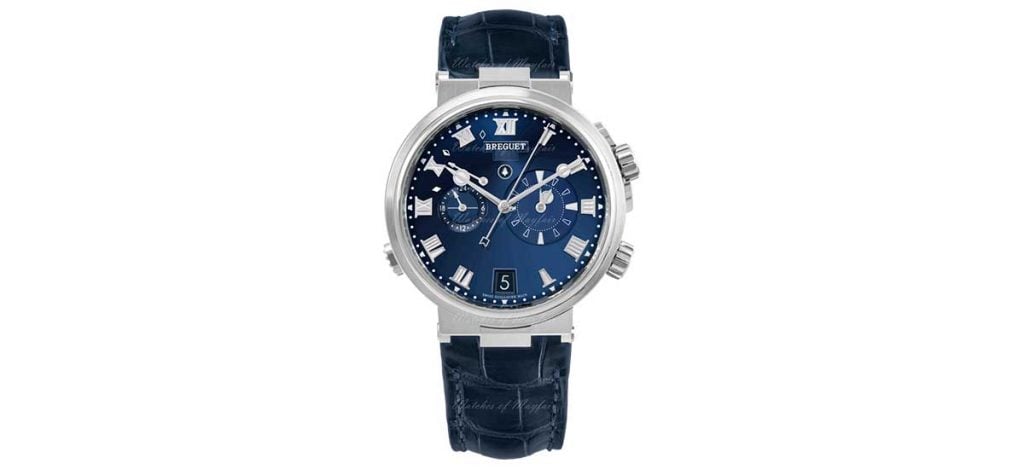
Breguet’s Marine Alarme Musicale 5547 offers a sophisticated alarm function within a maritime-themed design that pays tribute to the brand’s founder, Abraham-Louis Breguet. Introduced in 2019, the watch comes in a 40mm titanium case and possesses a sunburst slate grey dial with an array of displays.
Some might even say too many displays – an alarm subdial at 3 o’clock, a 24-hour subdial at 9 o’clock, an alarm activation aperture at 12 o’clock, and a power reserve indicator for the alarm between the IX and XII Roman numerals. It’s a lot, frankly.
However, if a complex dial excites you, as it does many, then this is right up your street. The watch gets its juice from the self-winding 519F/1 caliber, which features two separate barrels to provide energy to the main movement and the alarm mechanism, respectively.
The alarm function is easily activated using a pushbutton and has a high-pitched tone. Priced at $28,600, the Alarme Musicale 5547 represents great value for money in terms of technicality and build quality if you find this kind of facade appealing.
Richard Mille RM 62-01

Hold on to your wallets; this one is pricey. Richard Mille and Airbus Corporate Jets (ACJ) launched the RM 62-01 Tourbillon Vibrating Alarm watch in 2019. In true Mille fashion, it was the most complex watch the firm had ever created at the time – one designed with a focus on the traveler, with an alarm function intended to be discreet and exclusive, transmitted purely by vibrations that only the wearer could perceive.
This makes the watch uniquely intriguing, as to benefit from the complex alarm function, the wearer has to be wearing the watch. Perhaps more interestingly, the vibrating alarm was designed not to affect the movement, which was obviously a significant concern. Thus, a solid gold offset weight was used to transmit the vibration, inspired by the vibrating function of earlier mobile phones, which is a strange dichotomy in its own right.
It took extensive research and development to fit 816 parts, 2 barrels, 7 hands, 11 displays, and a tourbillon cage into the limited volume of the watch case; a watch constructor needed five years to create the timepiece. Patience truly is a virtue.
Being a Richard Mille watch, after all, the RM 62-01 is limited to 30 pieces, each one going for $1,225,000. It embodies the paradox of being supremely easy to use while being a complicated watch, an accomplishment that evidently commands a hefty sum.
Hublot Big Bang Alarm Repeater Titanium (403.NM.0123.RX)
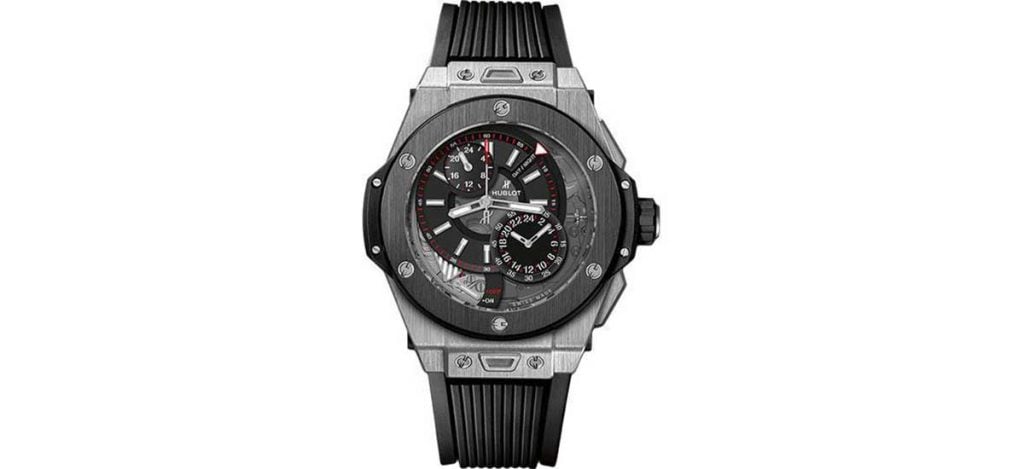
Hublot’s limited edition Big Bang Alarm Repeater watch came out in 2015 and notably combines the functionality of a mechanical alarm with a minute repeater, resulting in a more elegant sound than traditional alarm watches.
The timepiece features a gong and hammer system and a semi-transparent dial made from several colored layers of sapphire crystal, which is very representative of the Hublot vibe – proudly complex and stylistically bold. Furthermore, the off-center dial places this piece in its own camp among Hublot’s releases, adding an extra element of individuality to the watch.
The manually-wound movement was designed and produced by Chronode and is almost exclusive to Hublot, with only a small number of Cyrus watches also able to use the movement. It features a silicon escapement system, 72-hour power reserve, time with a 24-hour indicator, a 24-hour dial to set the alarm time, and an on/off switch for the alarm complication.
The case is that of the Big Bang 45 (which is no stranger to those familiar with Hublot), which has a unique pusher design and a matte black ceramic bezel. Limited to 250 pieces, the Big Bang Alarm Repeater is priced at $56,300.
Vulcain 50s Presidents (210150.276LF)
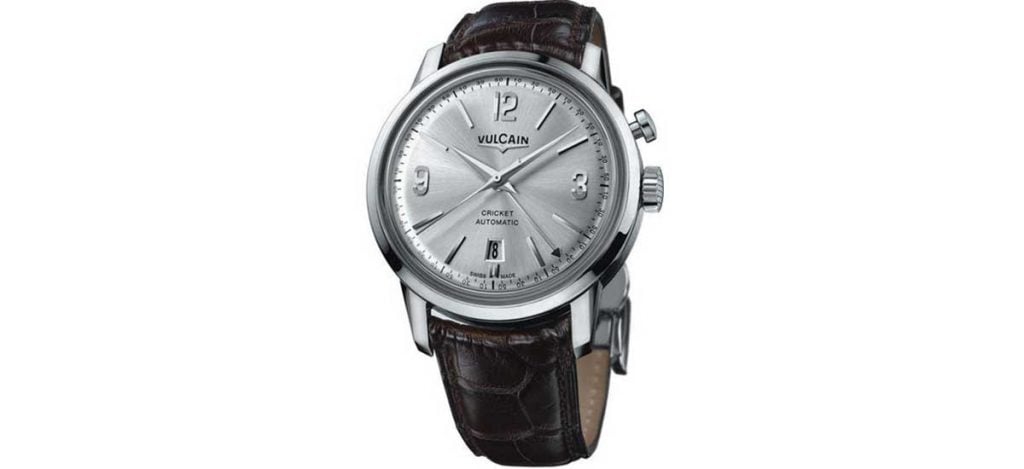
Vulcain’s first alarm complication on a wristwatch in 1947, and the models that followed, have been worn by almost every US president since Truman. But, these paradigmatic watches have also spurred many horological innovations over the years.
The movements for these are still almost entirely in-house and beautifully finished, enclosed in resplendently branded vintage-style cases. The company’s newest take on the Cricket exhibits a striking silver dial with beveled hour markers and classic dauphine hands.
A polished stainless steel case sits at 42mm, slightly larger than what one would expect from a watch inspired by the mid-century style. However, the purposeful addition of a cambered sapphire crystal maintains the vintage look perfectly.
Inside the Cricket is the V-11, a manual movement manufactured by Vulcain, which has two barrels, a 42-hour power reserve, and a new ‘Exactomatic’ system that improves regulation of amplitude and reduces wear, resulting in increased accuracy.
The movement is expertly finished, with beveling and dressage throughout, and the crown and ratchet wheels have an exotic, almost Aztec-like design. With this immutable wearability and timeless design for $5,200, can you really afford not to buy it?
Panerai Radiomir GMT/Alarm (PAM00098)
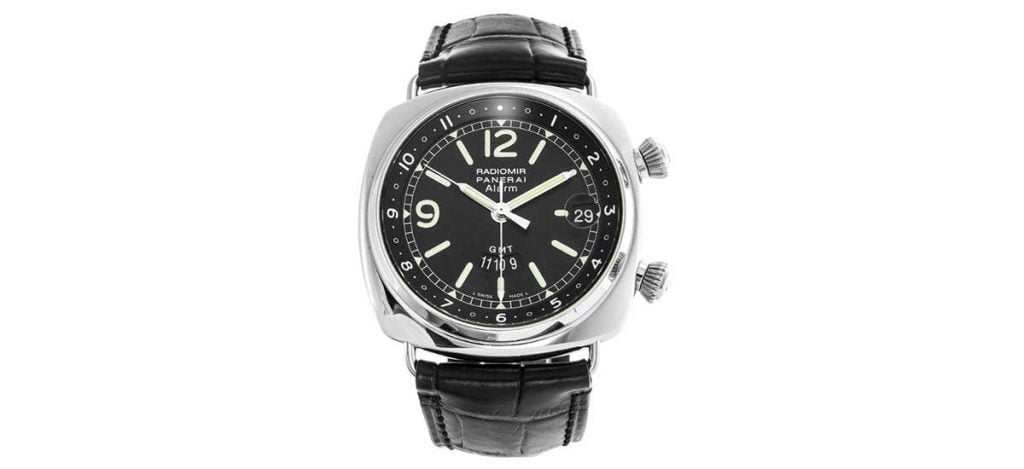
This Panerai is a suave timepiece that just oozes style and functionality. That is, a very specific style and a very reliable set of functions. Produced in 2008, this watch features a robust steel case with a diameter of 42mm, paired with a handsome brown leather strap; it’s perfect for everyday wear.
Like many on this list, the watch has no better use than keeping frequent travelers on schedule. And boy, does it do that in style, with its soft square case and stark black face. If there’s one thing Panerai knows, it’s how to turn a head. Legibility was clearly a priority when designing the watch, as the dial remains uncluttered despite having a date window and GMT window.
That’s right – GMT window, not dial. Bold Arabic numerals and luminous hands further add to this dynamic. The Radiomir is equipped with an automatic movement with a generous power reserve of 47 hours and 31 sparkling jewels, ensuring optimal performance.
The buckle clasp adds an extra layer of security and style to the already stunning leather strap. And with a water resistance of 30 meters, this watch is well suited for everyday wear, marrying both style and functionality in a way that only Panerai knows how.
Jaeger-LeCoultre Master Compressor Diving Alarm (Q183T770)
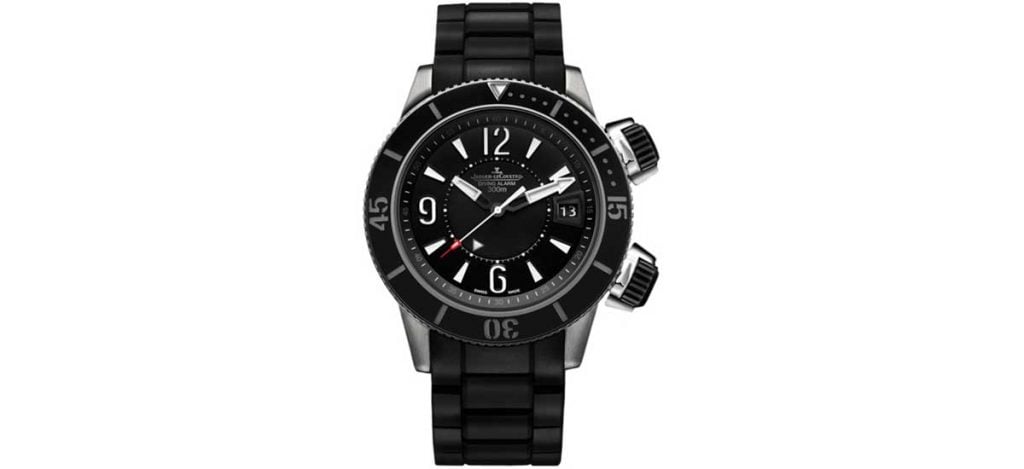
As with a few other watches on the list, this JLC is a limited edition. Specifically, it’s a run of 1500 units, made in partnership with the United States Navy Seals, and you can bet that it lives up to the label granted to it by the special forces.
A 44mm titanium case and a ridiculously scratch-resistant ceramic bezel provide ample framework for a deafeningly black face with contrasting white indices and Arabic numerals at 6, 9, and 12. There’s a double-sealed date window at 3 o’clock, and of course, the center of the dial represents the alarm function, with a rotating arrow marker indicating the current alarm time setting.
It almost goes without saying that this is a hefty watch – its 300-meter water resistance requires only as much; therefore, the Master Compressor isn’t recommended for those with a more slender disposition.
The inner workings are impressively detailed, though; laser-welded hairspring, 45-hour power reserve, and ceramic winding rotor bearings are a few of the components wrapped up in the automatic JLC caliber 956. This is a serious watch, for serious people, with serious wrists.
Ulysse Nardin Sonata Cathedral Dual Time (670-88/213)
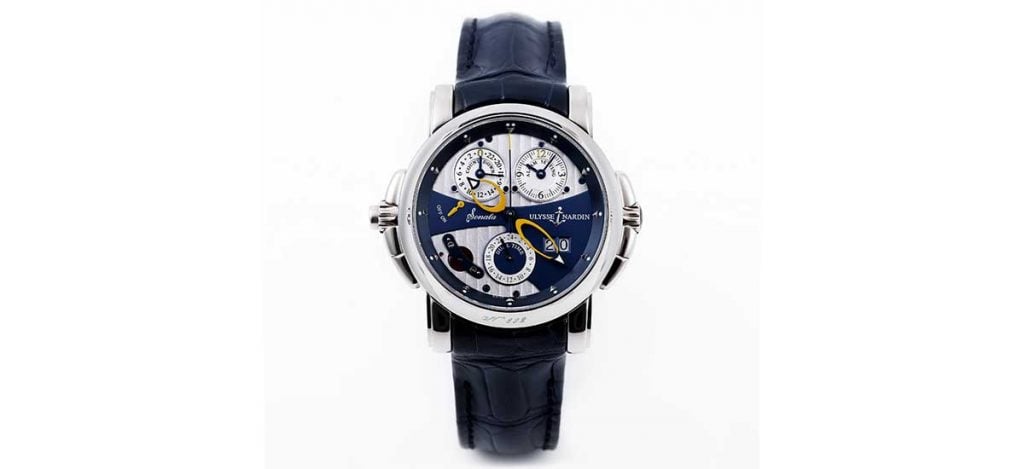
The Ulysse Nardin Sonata Cathedral Dual Time stands out due to its advanced execution of multiple impressive features, all represented on a very ‘Jetson-esque’ dial. That’s right – I just referenced a cartoon. A big date complication is accessed through the left-hand crown, which can wind both forwards and backward.
It also allows the user to access a second time zone with the push of a button without even taking the watch off. As if that’s not impressive enough, a 24-hour alarm function can be set once and forgotten, much like its digital counterparts, and the countdown timer display helps the user to know whether the alarm is set for AM or PM.
Finally, the watch has a cathedral gong that sounds for its alarm, providing a rich, clean sound that is undeniably unique to this model. The Ulysse Nardin calibre UN-67, which has over 400 parts, ensures that the watch is intuitive to use, so, despite any initial trepidation regarding its complex dial, you can rest assured that you won’t need an instruction manual for this one.
Fortis B-42 Flieger Chronograph Alarm (657.10.170)
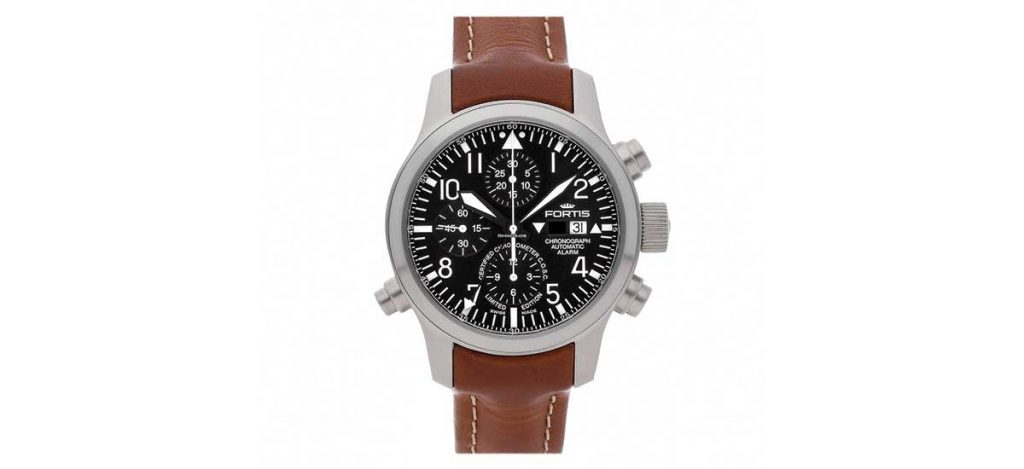
Introducing the Fortis B-42 Flieger (Flyer) Chronograph Alarm, the perfect combination of sporty and elegant, or at least, the military representation of these things. The dial is minimalistic and impressive, embossed and blued with hour numerals that stand out and are provided with index bars and tritium.
Steel skeleton hands with small luminous elements add to the watch’s ultra-functional design. Brushed stainless steel makes up most of the case, which is waterproof up to 200m, while the rest consists of sapphire crystal with anti-glare treatment (on both sides).
The transparent caseback provides a clear view of the decorated movement and rotor parts, which are made according to historical style. The watch is equipped with a self-winding chronograph movement with an alarm function, developed by the renowned watch artist Paul Gerber and based on the ETA movement Valjoux 7750.
With a COSC-certified chronometer, 32 jewels, and precision regulation, this watch is as accurate as it gets for the money. The B-42 Flieger Chronograph Alarm comes with a reptile leather strap or stainless steel bracelet, both with a tang-type buckle or folding clasp, respectively.
Oris Artelier Alarm (01 908 7607 4091-Set LS)
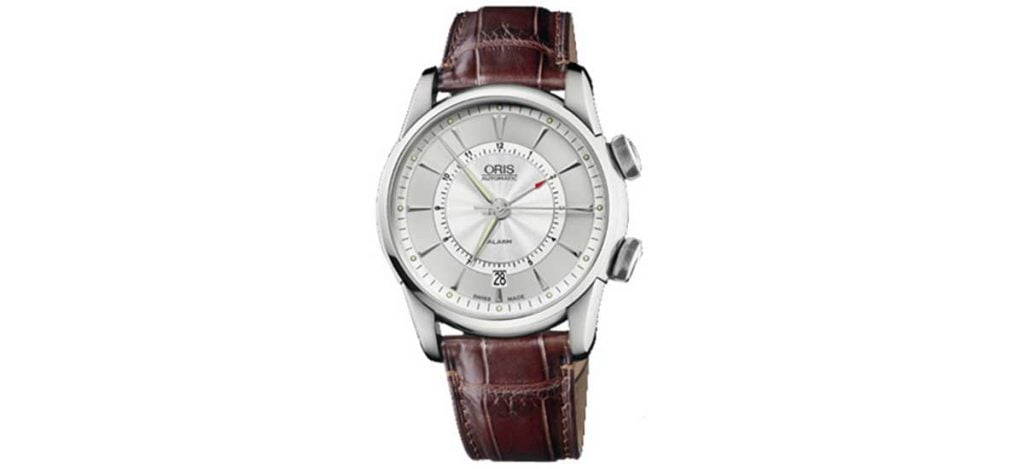
What I love most about this timepiece is the subtlety of its immodesty – a well-polished stainless steel case, well-machined index hour markers, a silver and grey guilloche dial, luminous hands, and detailed Arabic numerals ringing the central alarm dial.
To the layman, this is a basic timepiece, but to someone who knows what it takes to make a watch like this, it’s a gem. At 42.5mm in diameter, it’s an easy-wearing piece on most wrists and, in fact, wears rather small despite being just over 14mm thick.
The caseback is transparent, and the dial lies underneath anti-reflective sapphire. It’s about as easy to read as a watch gets, and with the Oris Caliber 908 humming along at 28,800 vph, it’s also about as accurate as a watch in this price bracket can be.
Although there’s little to write home about in terms of complications (unless your parents are horologists), the alarm is audibly pleasant, and the movement is reliable. Slap it on a brown crocodile leather strap with a push-button deployment buckle, and you’ve got just about all you need, replete with class and decorum.
Omega Seamaster Memomatic (166.071)
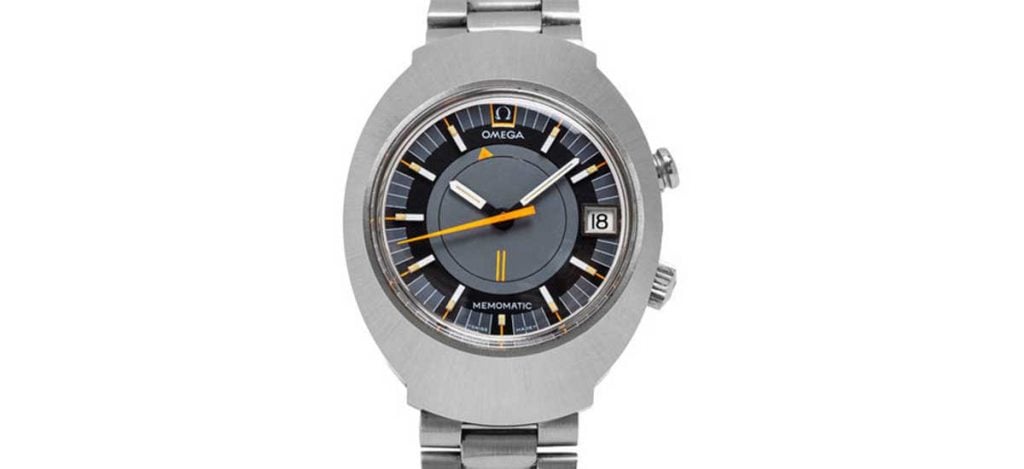
Released in 1971, this Omega is every bit as weird as it is intriguing. At the time of its debut, it was the only watch with an alarm that could be set to the minute, which is a feat deserving of your respect, at the very least.
It’s got a slight ‘racing’ quality to it, which it earns as a result of the very red seconds hand and the alarm arrow, but the main sense one gets from this design is that it’s rather artsy. The brushing of the stainless steel on this wide-bezel case (let alone its unique oval shape) is far from your average stylistic choice.
Coupled with the varying colors of the dial, this makes for a very unique Omega, a Swiss watch that looks more similar to Seiko’s Bell-Matic than any other. The automatic caliber 960 runs the show here, offering an alarm function and a quick-set date – a simple but effective movement that, as you might expect from the brand, is as accurate as you’d ever need it to be for daily wear.
There’s nothing outwardly special about the Seamaster Memomatic. It’s simply a watch so particular in how it looks that it will surely catch the eye of those who love its aesthetic.
Vulcain Nautical Cricket
This complex masterpiece exudes a charm straight out of the ’60s that is very difficult to find on modern watches today. Through a domed crystal, the dial shines in its unique nature, enriching the piece with a very distinct feel that I have never seen emulated before. It may take some getting used to, but if you were to wear it on a consistent basis, you will get used to this watch’s legibility, which might turn some off at first.
The alarm function, however, does add an impressive amount of tech to your experience. Winding and setting the watch is done at the 3 o’clock. You can turn the barrel clockwise to wind the alarm, and counterclockwise for the mainspring. Be sure to remember when you set it, though, because if you forget to turn it off, it will go off again twelve hours later when it hits the same time.
Regardless of the complexity, this is a watch worth taking a closer look at. It measures 42mm in diameter and sits very high on the wrist thanks to the triple caseback that provides a steady amount of support. And whether or not you deem it worth daily wear, this watch comes with beautifully polished and brushed finishes on the case that help it blend into everyday environments.
The Vulcain Nautical Cricket costs $5,975.
Wake Up to The Mechanical Alarm Watch
Looking at the watches on this list, I see one distinct through-line. No, it’s not the fact that they all have an alarm. I see that these watches represent a unique and storied period of innovation and creativity that gave rise to an entire paradigm of interest in the horological world.
These are pieces so specific in their function that they demand attention, regardless of where or not they’re the pinnacle of technological advancement. They’re worth your time because they’ve taken up so much of our predecessors’ time; it’s that simple.
With that being said, if I’m pushing for any sub-set of watches to make a strong comeback, it’s undoubtedly the mechanical alarm.


